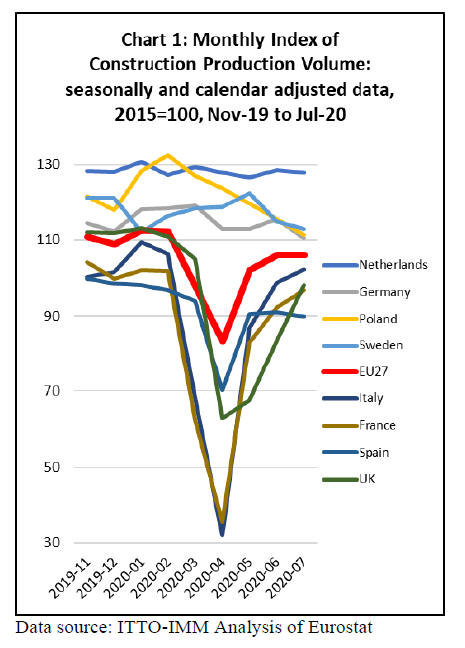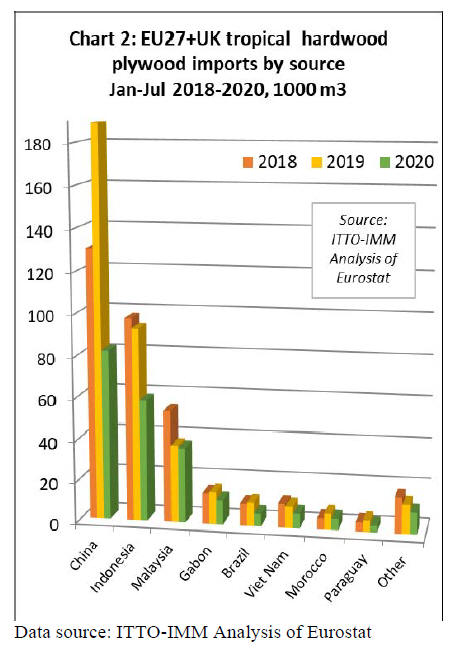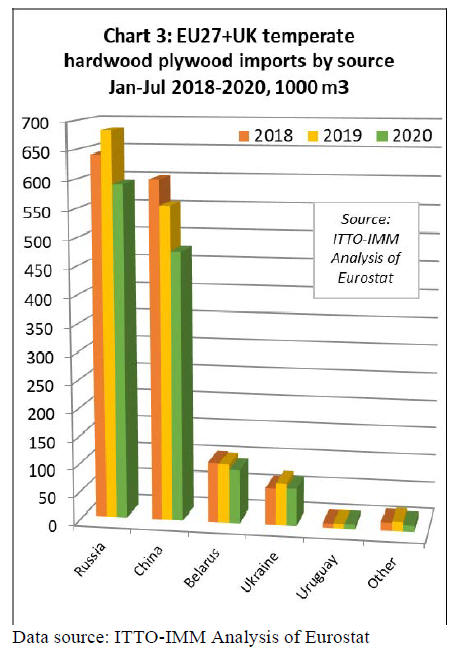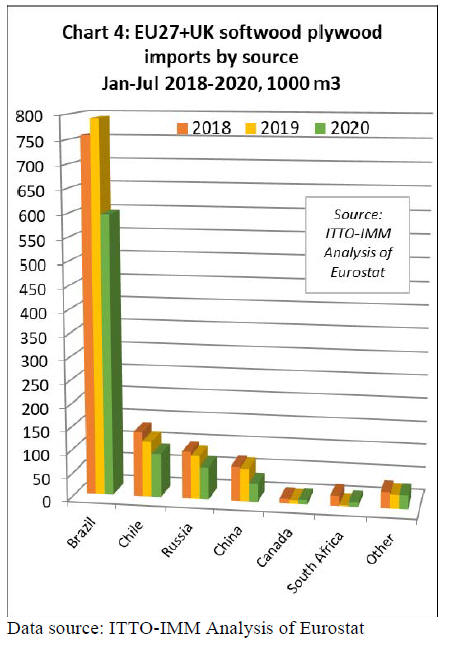|
Report from
Europe
EU plywood trade cautious, but recovery faster than
expected
It¡¯s still too early to say for sure, but it¡¯s variously
estimated by European plywood importers and distributors
that the Covid-19 pandemic will slice 10-20% off their
2020 bottom line.
Trade has since seen a bounce back, varying in degree
from country to country, but companies don¡¯t expect it to
make up for the sales lost when the health crisis first hit.
Looking ahead, the sector is hopeful about continued
market recovery, although there¡¯s awariness about making
more than short-term forecasts and concern about the
economic fallout as European governments wind down
pandemic business support measures.
There is some preoccupation too about the potential
impacts on the European economy of Brexit if the UK
does come to the end of its transition period to depart the
EU on January 1 and leaves without a trade deal.
The better news, however, is that, while plywood
companies across Europe acknowledge that they¡¯ve taken
a significant hit from the pandemic, the general view is
that the contraction in trade has not in fact been as severe
as expected earlier in the year.
¡°In normal circumstances, losing a tenth to a fifth of sales
would be seen as a bit of a disaster,¡± said one importer.
¡°But if you¡¯d offered us that when we were at peak
lockdown, we¡¯d have grabbed it with both hands. At one
point we were trading at between 30 and 35% of normal
levels.¡±
This expressed the general consensus. Some companies
closed for a period late March into April. Most kept
trading, but report that they were mainly dealing with
outstanding orders.
¡°There was new business coming into the pipeline, but it
was significantly down and more hand to mouth,¡± said an
importer/distributor. ¡°Very few customers were
committing more than a few weeks ahead. We actually
kept all our staff on, but it was as much to keep
communications channels open with customers, as to
actually do business.¡±
But the worst of the crisis was, in the words of one
company, ¡®surprisingly short-lived¡¯. Business was reported
to have started recovering as early as May and picked up
from there.
¡°An indicator that things didn¡¯t turn out quite as bad as
customers expected was that we got calls in April asking
for longer payment terms, then in May they came back to
us and said that they no longer needed them,¡± said an
importer distributor.
Some businesses report that they were already back to pre-
Covid trade levels by June and that momentum continued
to build in July.
¡°Early on, part of the uptick in activity was due to delayed
supply shipments coming in and completing outstanding
orders that we¡¯d been able to fulfill before,¡± said an
importer. ¡°But new orders also started to increase.¡±
August dip in continental European plywood trade
Some plywood businesses in continental Europe said that,
after trade strengthened through June and July, it dipped
again, in some cases sharply, in August.
¡°This seems to be because people went ahead with
vacations, even if they were staycations,¡± said an importer.
¡°We anticipated once customers got back to business post
lockdown and staff returned after furlough or technical
leave, they¡¯d work through the summer period. However,
trade did slowly get back to recovery in September.¡±
The exception to this trend was the UK. ¡°We don¡¯t have
the continental summer vacation pattern, and we saw sales
continuing to accelerate through July and into August,¡±
said a UK importer.
The European construction sector, the main plywood
consumer, was severely affected by the pandemic in April
but recovered strongly in most countries in the following
months. According to Eurostat figures in April EU27
construction output slumped by 15% compared to March
but made up much of the lost ground in May and June
(Chart 1).

The construction sector was hit hardest in April in Italy,
down 53%, France, down 43%, and Spain, down 25%.
Construction in the UK also fell rapidly in April, down
40%. Although production rebounded in all these
countries in the following months, it was still down on the
long-term average in July.
In contrast, construction production in the Netherlands,
Germany, Poland and Sweden was less affected during the
first wave of the pandemic.
On the basis of current data, Euroconstruct predicts that,
after expanding 2.7% in 2019 to €1,700 billion,
construction output in its 19 European member countries
will contract 11.5% (compared to a GDP decline of 8.8%).
This will take revenue down to around €1,500 billion, the
lowest level since 2015.
Recovery is expected to set in next year, with output rising
6%, followed by 3% growth in 2022. However, the
pandemic over the 2020-22 period is forecast to cost
construction around €350 billion in lost business.
Over this year, only Portugal and Poland among
Euroconstruct countries are expected to see building sector
growth, while the smallest contractions will be in
Switzerland and Finland, down 1-2%.
Of the big five, Germany is predicted to fare best, with a
2.5% construction downturn, and the UK worst, with
output 33% lower. Building in Spain is forecast to contract
15%, France by 17.8% and Italy 11.4%.
These figures tally with comments from plywood
companies in different countries, although a number gave
a more upbeat perspective on the rate of recovery in
construction, with government investment programmes
expected to give the industry a further boost in various
countries.
¡°In two of our leading construction markets, Germany and
the Netherlands, we saw activity continuing quite robustly.
There was some slowdown, but few sites closed, and from
May onwards demand has picked up steadily,¡± said an
importer.
¡°In Germany, in particular we see strong prospects for the
industry. After a period of under investment, for which it
was criticized by the EU and UN, Germany started a
multi-billion euro infrastructure and public construction
spending programme about two years ago, and that
continues. So we¡¯re expecting good growth in the market.¡±
While construction suffered worse in France, public
investment is also expected to underpin recovery and
growth.
¡°The French government says its recovery investment
package will eventually add up to 4% of GDP, the largest
percentage spend of any European country,¡± said another
importer. ¡°It maintains that this should get GDP to pre-
Covid levels by 2022, and €7 billion is earmarked for
building renovation and increased energy efficiency.
Additionally, as part of its sustainable development
programme, France is introducing a law in 2022 whereby
timber will have to make up 50% of construction materials
used in new public buildings. In line with this, a
significant part of construction for the 2024 Paris
Olympics will be in wood.
¡± The pace of recovery in other European countries was
expected to depend on the resources governments have
available to boost their economies. ¡°The deeper their
pockets, the sooner they¡¯ll get back on track,¡± said an
importer-distributor.
Early signs of recovery in UK plywood market
While Euroconstruct forecasts the UK building sector to
suffer the steepest downturn of its member countries, bar
Ireland where contraction is predicted at 38%, a UK
importer also reported good signs of recovery from June
through August.
¡°In fact we had one of our best Julys ever, not just for
plywood, but also OSB and the range of wood panel
products, and construction contributed significantly to
that,¡± they said.
¡°Looking forward, the government has also pledged to
increase funding for public building projects and the
refrain is that we¡¯re going to build back better and
greener, which should hopefully open the door to greater
use of timber.¡±
Of other markets, the DIY and repair maintenance and
improvement sectors are both reported to have come
through the pandemic relatively strongly, and now to be
picking up well.
¡°It seems consumers turned to DIY projects during
lockdown,¡± said an importer. ¡°In addition, the money
they¡¯re not spending on holidays and going out is going
into home improvement.¡±
Of other plywood markets, furniture and joinery
manufacture seem to have taken longer to recover,
although activity is now said to be on the up. Worst
affected are reported to have been packaging, hit
especially by the general downturn in manufacturing, and
shopfitting, with retail already suffering going into
lockdown, in part from continuing growth in online
shopping, which the pandemic has further accentuated.
The hospitality sector has also been badly affected, as has
the trade exhibition industry.
¡°By July/August our sales into construction, which form
the biggest part of our plywood trade, were back to 90% of
normal, with furniture and joinery around 50% and
increasing,¡± said an importer. ¡°But shopfitting and
packaging were still some way behind. And the exhibition
sector, which is a significant panel products market, was
just flat and we don¡¯t see it coming back significantly even
in the first half of 2021.¡±
A UK importer distributor, however, did see some signs of
revival in shopfitting from August. Sales of wood sheet
materials for ¡®distancing screening¡¯ in hospitality and
healthcare sectors also to some extent made up for
business lost elsewhere.
Steady recovery in European plywood deliveries from
China
In terms of supply the major concern early on in the
pandemic was China. ¡°When they went into lockdown, as
far as we were concerned, they just turned off the tap,¡±
said one importer. ¡°We didn¡¯t see deliveries from
February, through to early April. We and our customers
had to live off inventories.¡±
However, through April and May, Chinese supply was
reported to have recovered steadily, and in the summer to
be back to normal. One importer reported a ¡®surge of
outstanding deliveries in July¡¯.
Increasing freight rates, up in the last couple of months
from $1,300/1,400 FEU to $2,000 are now impacting
Chinese competitiveness. In addition the strengthening of
the CNY against the dollar, plus increased veneer prices
due to the effects of bad weather on supply, are reported to
be prompting Chinese suppliers to push for 3-5% price
increases.
¡°However, there¡¯s a lot of market resistance and that could
lead to some issues with quality, with factories cutting
back on standards if they can¡¯t get price rises,¡± said an
importer. ¡°With China, you get what you pay for.¡±
Some gaps are reported to be opening up in Brazilian
supply as demand from the US construction sector
continues to grow strongly. Consequently prices are up
too.
¡°While production has continued, Brazilian through the
pandemic has been a real roller coaster,¡± said an importer.
¡°At the start in March the price for standard 20mm C+/C
dropped from US$230/cu.m FOB to $170 due to
contraction in international demand, then dipped even
lower. Now it¡¯s back to US$250-280/cu.m and it¡¯s mainly
due to an increasingly active US market.¡±
Russian plywood squeezing out Indonesian suppliers
Indonesian plywood supply is also reported to be almost
back to normal, albeit with freight rates increasing costs.
One importer, however, said they were now only buying
raw board from the country.
¡°Thinner Indonesian product is also still doing OK, and
they¡¯re strong in overlay and 2.7mm items for the caravan
industry, but, for us, they¡¯re pretty much out of the picture
in 18-21mm film-faced for construction, where Russian
dominates,¡± they said.
Russian plywood is reported to have become more
competitive overall with the rouble sliding from 77 to the
euro in June to over 90 in September.
¡°At the same time, some Russian mills have been pushing
for price rises in certain upper end qualities as they¡¯re
facing shortages of logs and quality veneers until the next
harvest season starts,¡± said an importer.
Reflecting the impact of the pandemic, analysis of
Eurostat¡¯s Comext figures show total tropical hardwood
imports into the EU27+UK were down 42.4% to 221,000
cu.m from January to July, compared with the same period
in 2019.
Biggest falls came in imports from China, down 56.6% to
82,000 cu.m. Shipments from Indonesia were 37.1% lower
at 58,000 cu.m, from Malaysia down 2.8% to 36,000 cu.m,
Gabon down 23.8% to 12,000 cu.m, Brazil down 46% to
6,000 cu.m and Vietnam down 31.7% to 7,000 cu.m
(Chart 2).

EU27+UK combined temperate hardwood plywood
imports for the period fell 13.4% to 1.25 million cu.m,
with Russian imports down 13.5% to 591,000 cu.mm,
Chinese down 14.2% to 477,000 cu.m, Belarusian down
9.1% to 95,000 cu.m and Ukrainian down 10.6% to 67,000
cu.m, while Uruguayan imports were up 0.8% at 9,000
cu.m (Chart 3).

EU27+UK total softwood plywood imports over the same
period were 23.9% lower at 847,000 cu.m, with Brazilian
24.7% lower at 597,000 cu.m, Chilean down 22.1% at
93,000 cu.m, Russian down 24.7% at 70,000 cu.m and
Chinese down 44.9% at 39,000 cu.m. Imports from
Canada rose 26% to 9,500 cu.m and South African
increased 311.8% to 10,000 cu.m (Chart 4).

No-deal Brexit threatens European market confidence
Turning to Brexit, there remain fears if the UK leaves the
EU without a deal, it could further undermine European
market confidence, which is already fragile due to fresh
spikes in incidence of Covid-19 in a growing number of
countries. But late September, negotiators on both sides
were making more conciliatory noises and sounding more
positive a deal would be struck.
A leading UK importer added that, while they remained
concerned about hold ups at ports and customs as new
administrative procedures bed in in the event of a no-deal
Brexit, they were not hedging by increasing stocks.
¡°We always keep a buffer and don¡¯t anticipate we¡¯ll need
more than this,¡± they said. ¡°In addition, all our competitors
will be in the same position.¡±
Another importer said they were cautious about building
stock in case the current ¡®US demand bubble¡¯
underpinning the global market bursts. ¡°In that case prices
would drop,¡± they said.
UK companies added that they were not ¡®overly anxious¡¯
either about having to undertake due diligence on imports
from the EU under the new UK Timber Regulation, which
succeeds the EUTR in the UK, if a deal is not struck.
This includes FLEGT-licensed product imported via EU
countries.
¡°We have the systems in place, and are already subjecting
Latvian plywood and OSB to due diligence, for instance,
so we don¡¯t see it as a significant additional administrative
burden,¡± said one company.
One complication is the position of Northern Ireland post
Brexit. Under the original ¡®Withdrawal Agreement¡¯
concluded by the UK and EU, it remains subject to the
EUTR, so goods shipped from the rest of the UK to
Northern Ireland would have to undergo due diligence and
be subject to the same duty as those imported into the
province from other non-EU countries.
However, under the UK government¡¯s recently proposed
Internal Market Bill, goods could be shipped to Northern
Ireland without any checks or duty, in which case those
exported from Northern Ireland to the Irish Republic
would be subject to EUTR due diligence.
¡°About 10% of our turnover comes from goods exported
to the Republic via Northern Ireland, and this uncertainty
is not helpful,¡± said a UK plywood importer. ¡°But we have
been assured, we won¡¯t be paying duty twice.¡±
Brexit deal or no Brexit deal, all UK imports from outside
the EU will be subject to the duty rates in the new UK
Global Tariff unless:
the supplier country or region has a trade deal
with the UK
a developing supplier country has Generalised
Scheme of Preference status with the UK
an open Product Quota has been registered with
the WTO.
That said, many of the duty rates will be unchanged from
those of the EU. Some will be lower.
As for quotas, this includes the EU Coniferous Plywood
Quota. According to the UK Timber Trade Federation, if
the UK strikes a trade deal with the EU, then it will
continue to take its share of this annual quota, as before. If
not, plywood from the EU will count as part of its share of
the quota.
¡°Our understanding is that the UK will have its own duty
free softwood plywood quota of around 167,000 m3
starting January 1, 2021, which is based on its usage of the
[EU] quota over the past five years,¡± said a TTF
spokesperson. ¡°If we do not sign an EU deal then
coniferous plywood from Finland, France and Sweden will
have access to the quota along with the rest of the world so
it is likely to be used up faster than before.¡±
Also in EU plywood sector news, the Dutch EUTR
Competent Authority has ordered the Netherlands
company Sakol to stop importing tropical-faced plywood
from Chinese supplier Jiangsu High Hope Arser Co. Ltd,
which it deems in breach of the Regulation.
The Environmental Investigation Agency NGO says the
move sets a precedent for the rest of the EU, and it urges
Competent Authorities in France, Belgium, Greece, and
the UK, which import similar products from China, to
follow the Dutch example.
¡°This decision is significant as it delivers a blow to the
protective cover that these global supply routes have
provided for high risk and illegal tropical timber and
shows that European authorities are rising to the challenge
posed by complex timber supply chains,¡± said EIA Forest
Campaigns Director Lisa Handy.
¡°For the EU to demonstrate it is truly a level playing field,
and if the UK does not want to become a back door for
illegal tropical timber in the region, the decision taken in
the Netherlands should trigger a domino effect across
Europe. We look forward to other authorities taking
similar actions.¡±
On the trade outlook, EU plywood companies highlight
continued downside risks in the market. These include
further increases in new cases of Covid-19 ¨C the so-called
pandemic ¡®second wave¡¯. Importers are also concerned
that unemployment will rise as governments withdraw
worker furlough support, with a consequent loss of
consumer confidence. Some expressed a worry too about
sufficient new construction work coming on stream,
despite public investment, once pandemic-delayed projects
are completed.
However, the sector is not overly downbeat. ¡°We¡¯re in a
better position now than we expected to be six months
ago, and at the moment we¡¯re seeing recovery continuing
to pick up,¡± said an importer. ¡°We¡¯re taking things week
to week, month to month, as the picture is so uncertain,
but we¡¯re cautiously optimistic.¡±
|